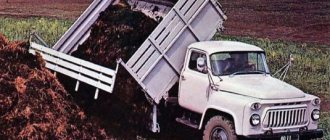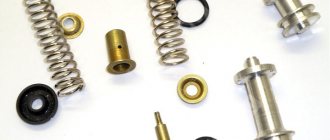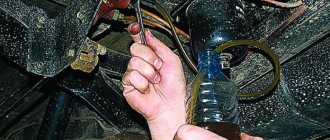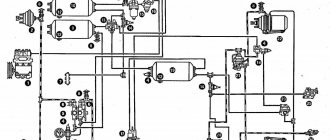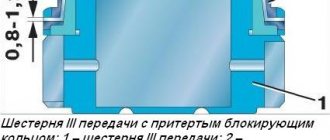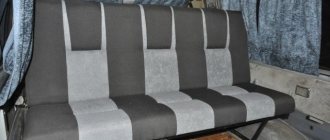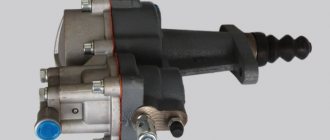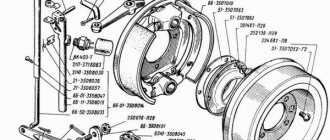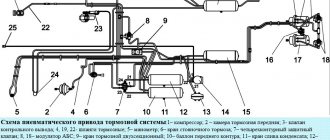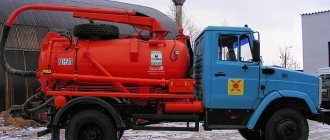The effective operation of a properly functioning braking system directly affects the safety of traveling in a car. The main requirement for the braking system is to ensure a quick stop of the car in a minimum period of time. This is what the vacuum brake booster, or VUT, is responsible for, which first appeared on UAZ Bukhanka cars at the end of 1988. By the way, in order to install the VUT, the designers had to slightly change the kinematics of the front springs of the car and redo the front suspension.
But we will not go into design nuances, but will immediately move on to a more pressing topic: how to check the vacuum brake booster on a UAZ “Loaf”.
Detailed diagram of the UAZ “Bukhanka” braking system
In the diagram, numbers represent the various components.
1) Brake disc; 2) Front wheel brake caliper; 3) Front contour; 4) Master brake cylinder; 5) Reservoir with brake fluid movement sensor; 6) Vacuum booster; 7) Pusher; Brake pedal; 9) Brake light switch; 10.22) Brake pads; 11) Rear brake cylinder; 12) Back contour; 13) Rear axle housing; 14) Load spring; 15) Pressure regulator; 16) Rear cable; 17) Equalizer; 18 Central cable; 19) Parking brake lever; 20) Brake fluid emergency level indicator; 21) Parking brake warning switch.
The braking system of the UAZ “Bukhanka” has its most common breakdowns. For example: increased braking distance, sinking brake pedal, creaking and noise when braking, leaking brake fluid.
The causes of all these problems are also known. This, as a rule, is a violation of the tightness of the system, low level of brake fluid, wear of the pads and untimely replacement of consumables.
In most cases, if the problems are not related to wear of parts, simply bleeding the braking system will help. It is performed during any depressurization of circuits, during renewal of brake fluid, as well as during any replacement of system parts (pipes, hoses, cylinders).
Do not forget that for pumping you will most likely need an assistant.
Knocks out a reduced one, with all rituals
In general, the wheels are 35, the lowering kit is 3.26, it knocks out the lowered one with an anti-knockout, an ideal transfer case housing, SKF bearings, gears are all new, the cut in the rod is made as it should, full engagement and that’s it, as long as you hold the lever so that the anti-knockout doesn’t knock out everything is ok. But I really want to It's a thrill to steer with both hands. Or is this the norm on heavy 35 wheels and the throttle is in the palace?
Comments 41
Well, I don’t drive low on asphalt, but in the mud it definitely won’t have any effect
That car didn’t even go on the asphalt and the problem was precisely the mud. They broke their whole head while they were sorting it out, well the idea came to measure the wheels - that was the problem (the wheels turn out to be spinning at different speeds and that’s why the transfer case gets knocked out)
This is how you have to do it
It means you have done something wrong. With this design, the lowered fork has nowhere to go. Thus I made six RKs. And not one of them has any problems with knocking out the lowered ones.
Yes, it’s clear that it has nowhere to go, when you hold it with your hand so that the lever doesn’t move to the right, it doesn’t knock anything out, but it’s wrong, the plug is on fire
I completely agree with you, the plug is “on fire”. I've had this system since I was 18, no problems so far. But with every oil change in the RC (I fill it through the top cap, a high oil level is needed. There are tapered roller bearings on the rear axle), I look at the wear of the fork-gear. Now it’s about 1.5mm. And so as not to hold it with your hands, you need to install a tension spring.
Yes, the spring is there, the car has a fresh anti-kickback from the factory, well, you can just throw in a stiffer spring, of course
How are the fork stems fixed? Like on old RKs - a bar with a bolt, or like on new ones - two locking screws. It happens on old gearboxes that the lowered rod moves outward and bends the locking plane—the gears engage incompletely. It’s still not entirely clear how the lever can pop out on its own with an anti-knockout device. To lock the anti-kickback, you need to pull the lever back to the lowered position, and then towards yourself. Thus, the lever moving the forks in the RC will catch with the cut on the front axle fork and will not allow the lowered fork to spontaneously move forward, because The front axle fork is rigidly fixed with a pin to a bar in the mechanism. To turn off the fixed low gear, you need to move the lever away from you and then forward. How do you hold the lever with your hand so that the lowering mechanism does not get knocked out? It turns out that the lever itself jumps to the right and forward? Is the spring that pulls the lever on the control valve located outside?
The rods are fixed with screws, first the anti-knockout mechanism pops out to the right and then knocks it out, and I have already made a cut in the fork itself so that the lever is not held by the cut but is completely flat, you can, of course, also hang springs.
If everything is perfect in the Republic of Kazakhstan, then all that remains is to repair the gearbox with replacement of the bearings of the primary and secondary shafts, especially the needle bearing between the primary and secondary shafts. Maybe they have a play that you can’t feel by hand, but the engine torque is enough to select this play. It turns out to be under heavy load due to the play of the bearings and the fact that the secondary shaft of the gearbox does not have support in the gearbox, it warps. When the gears are engaged in a lower gear, an axial force appears and the gear is knocked out. But this repair will not last long. I think that the design of this RK is rather weak for a 409 motor. I have experience that on a new Hunter with a mileage of 13 tkm, where the lowering gear was never turned on, it was knocked out in deep snow. Despite the fact that the old carb UAZ still has a two-lever gearbox without anti-kickout, the lowered one stays in place in the same snow and doesn’t knock it out (gearbox and gearbox after repair with replacement of all bearings).
So I have 409 daimos, 35 wheels and naturally it gets knocked out in shit up to the bumper, that is, under normal loads, and so I rushed across the field with gas to the floor, even at 5 lower, it doesn’t knock out anything
The next step is to fix the box
